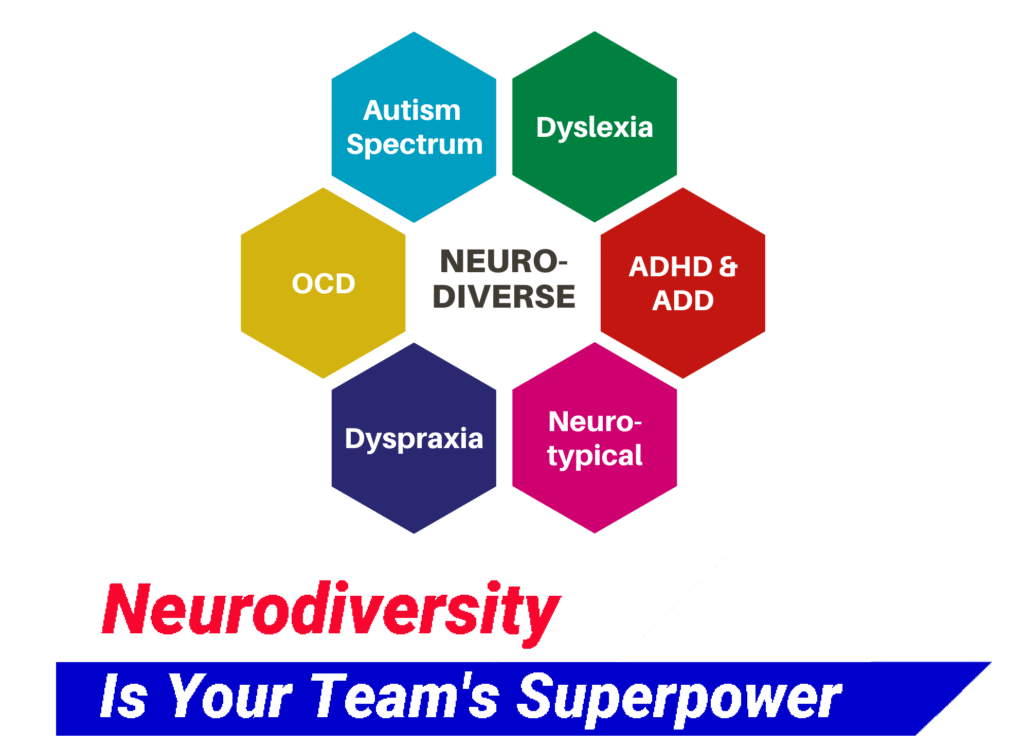Different Thinkers Can Include Dyslexic, Autism, ADHD, etc.
“Neurodiversity is the diversity of human brains and minds the infinite variation in neurocognitive functioning within our species” Nick Walker

We hire people like ourselves. This is an outward sign of unconscious and favorable bias towards people who are of the same race, education level, economic status, and values as the decision-maker. Kimberly Giles, Forbes Councils Member expands upon this concept in her article, “Why you Mistakenly Hire People Just Like You”.
This bias creates an organization that is comfortable with the way it behaves. At times, changes to the status quo provoke hostility towards behavior or ideas that challenge that version of normal. Countless women, LGBTs, minorities, and neurodivergent thinkers have buckled under that weight. Consequently, they left and took their talent elsewhere.
Divergent Thinking is Like an Artist’s Unique Rendering of an Idea
Great, enduring works of art succeed because of the richness of detail that inspires fresh views on life. Just like art can invite us to think about the world differently, so can including divergent thinkers in our lives and workspaces.
If we include this wealth of neurodiversity in every aspect of our organization’s functioning, everyone wins. Imagine the benefits if we move beyond allowing neurodiversity to exist in small pockets to embracing it in every aspect of our culture.

It’s encouraging that many forward-thinking companies are embracing the idea of including diversity of cognition into their workforce. Whether the motivation for these initiatives is altruistic, or financial, doesn’t matter. The groundwork needs to be the same. If companies want to be inclusive in their recruiting and hiring, they need to start by focusing on company culture.
If a company’s culture is such that minds are entrenched with how things should be, and ready to repel nonconformists, this will be a serious obstacle in the success of the neurodiversity initiative. Leaders who have done their research understand that the process begins by accepting that all humans are different. It’s the richness of our differences that makes our teams unique and successful.
Understand that Accommodations Increase Everyone’s Success
Susan Van Klink, Chief Revenue and Diversity Officer at Grokker, proposes reorienting hiring practices in order to bring out everybody’s best. This would counter the human tendency to hire people that fit our particular mold. Divergent thinkers who are extremely capable of doing a specific job often don’t get hired because they are not enough like those doing the hiring.
Ludmila Praslova, Ph.D., SHRM-SCP, an important voice in the neurodiversity-at-work initiative, is a professor and director of Graduate Organizational Psychology at Vanguard University of Southern California. She is a leader in the field of inclusive organizational design. Praslova explains that traditional hiring and interview practices fail inclusivity. She says job interviews traditionally focus on measuring candidates’ ability to small talk and put on a friendly face. Often, interviews focus on surface impressions rather than skills crucial for the job the candidate is going to perform. This dynamic also holds for promotions. She suggests that there is ”an assumption that to be promotable or high-potential, a person needs some degree of charisma, whether it’s relevant or not.”
The traditional approach does not favor socially awkward, neurologically diverse people, who might otherwise have skills to solve problems, exhibit creativity, and demonstrate what they know. A better option to approach interviews would be to focus on practical skills tests that eliminate unconscious bias. Hidden bias disproportionately impacts people with autism, or poverty, for example.
Your Company’s Inclusion May be an Illusion
Any high performing female employee who’s been passed over for a promotion while watching a less qualified male colleague get promoted understands that a job well done does not guarantee company advancement or inclusion. Neurodivergent thinkers understand this problem well. Many hide their disability so they’re not negatively impacted by their coworkers’ biases.
About Accommodations and Disabilities
This reminds me of when my son, who had a language-based disability, was told he should not be doing as well as he was in English class. The assumption was that if he had this disability, he couldn’t do well in English. His teachers were wrong. If he used strategies to overcome his language disability, he could write exceptionally well. However, his performance was viewed with skepticism. Some teachers refused to believe he belonged in an honors level English class. Again, they were wrong. They could not overcome their conscious stereotype: A student with a language disability doesn’t belong in an honors English class. As soon as he had an English teacher who did not share this prejudice, he got an A grade in English. Unfortunately, this same paradigm often exists in the workplace.
Practical Steps to Build a New, More Inclusive Culture
Several factors influence our opinions of other groups, as well as how we interact with them:
- Our social culture, or way of seeing things, imprinted in our youth
- Our real-time experiences, if any, played out in social interactions
- Opinions expressed by role models and other social influencers
So, first and foremost, the one non-negotiable for any diversity initiative is zero-tolerance for treating people like outsiders, which often leads to exclusion and other forms of workplace bullying. A welcoming and psychologically safe work environment must be a core value in a company that embraces neurodiversity in the workplace.
Considered the following steps for building a more inclusive company culture:
- Provide quality training experiences that promote deeper understanding and shift misconceptions about autism and other types of cognitive divergence. A webinar on the topic may allow a company to check off the box and claim the training was provided, however, it won’t do the job.
- Provide opportunities for practical experiences and interactions with neurodivergent team members.
- Begin the change in company culture in the Human Resources (HR) department and the recruitment process. The awareness that interviewing and recruitment begins the process of understanding divergent thinkers in any organization choosing to embrace neurodiversity.
- Create a workspace that is psychologically safe for neurodivergent employees. In fact, all employees will be more effective when the workplace culture fosters safety: safety for the open expression of ideas, for differences in work styles, for different learning and communication preferences, and for diversity.
- Reflect on your motivation for participation in inclusive hiring practices. Know your “why.” Is it to wave a neurodiversity banner as part of your company’s marketing strategy to win society’s favor? Is it because you really believe in the power of divergent thought? Is it because you’re having trouble filling positions and you’ve heard that autistic people make great coders? Be honest. The success of the initiative depends on the company’s motivation and culture.
- Assess your interview process. Do you need to redefine your ideal candidate? Does the job description focus on the basics and eliminate possibilities for divergent thinkers through omission? Does your interview process provide options for flexibility in how you learn about a candidate? Are we making decisions based on the skill the candidate has to do the job or how well that candidate makes eye contact, is warm, and engaging?
Invest the Time to Implement Neurodiversity Thoughtfully
None of these steps can be put in place overnight. This is just the beginning. As we grow as human beings and company culture, we will welcome employees with a broader range of life perspectives, experiences, and competencies. Customizing work environments to meet individuals’ preferences, abilities, and goals will become commonplace. Understand that these customizations don’t reduce the quality of work but rather enhance the quality of the work individuals and teams produce.
It’s a journey, and it’s worth it. Each of us are unique. Most of us want to be valued for the unique skills that make us the high performing employees that we are capable of being. This is achieved when we understand, accept, and embrace neurodiversity in the workplace.
Annotated References:
Nick Walker — Neurodiversity is the Diversity of Human Brains and Minds
The idea that there is one “normal” or “healthy” type of brain or mind or one ‘right’” style of neurocognitive functioning, is no more valid than the idea that there is one ‘normal’ or ‘right’ gender, race or culture.
https://autisticuk.org/neurodiversity/
Kimberley Giles — We Mistakenly Hire People like Ourselves
One of the main problems is subconscious bias — hiring people who are just like you. When you do find any small commonality, you tend to exaggerate it, and in the end, you misread people and put the wrong people in the wrong positions.
Susan Van Klink — Support Every Employee with Caring Accommodations
I was very much struck by Praslova’s admonishments to “stop making assumptions about people and what they need because you’ll unwittingly leave people out. You can usually see someone’s gender, race, or age, but it’s easy to ignore hidden disabilities.”
Ludmila Praslova — Dancing with Diversity: From Inclusion Illusion to Authentic Belonging
If diversity is being invited to the party and inclusion is being asked to dance, then belonging is being able to reveal that you can’t dance — and to still be included.
https://blog.shrm.org/blog/dancing-with-diversity-from-inclusion-illusion-to-authentic-belonging
Additional sources:
How to Lay the Groundwork for Neurodiversity in the…, https://www.linkedin.com/pulse/how-lay-groundwork-neurodiversity-workplace-you-want-susan.
Trickle-Down Humanity in a Time of Crisis: Where are those…, https://www.elephantjournal.com/2020/04/trickle-down-humanity-in-a-time-of-crisis-and-where-are-those-billionaires/.
Wellbeing and Neurodiversity: Supporting Every Employee…, https://www.linkedin.com/pulse/wellbeing-neurodiversity-supporting-every-employee-caring-van-klink.
Definitions as Referenced in this Article:
Neurodiversity is the diversity of human minds, the infinite variation in neurocognitive functioning within our species.
Neurodivergent, sometimes abbreviated as ND, means having a brain that functions in ways that diverge significantly from the dominant societal standards of “normal.”
Neurotypical, often abbreviated as NT, means having a style of neurocognitive functioning that falls within the dominant societal standards of “normal.”
Neurominority, any group, such as people with autism, which differs from the majority of a population in terms of behavioral traits and brain function
Definitions sources: https://neurocosmopolitanism.com/neurodiversity-some-basic-terms-definitions/
And https://www.collinsdictionary.com/us/dictionary/english/neurominority
CLICK HERE to visit the articles page.

Download Neurodiversity in the Workplace! – Free!
Bring Susan Fitzell, M.Ed., CSP
Top Neurodiversity Speaker
To YOUR Organization!

